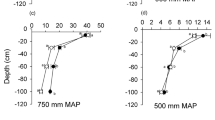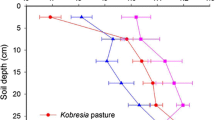Abstract
Woody plant expansion has been documented on grasslands worldwide as a result of overgrazing and fire suppression, but changes in ecosystem structure and function accompanying this phenomenon have yet to be extensively studied in the temperate semi-arid grasslands of North America. The primary objectives of this study were to determine the influence of woody plant expansion on soil carbon (C), soil nitrogen (N), and roots to a depth of 15 cm along a 42-year (1963–2005) chronosequence encompassing grassland, woodland, and transition zones in a northern Great Plains grassland. From these data, we also estimated ecosystem-level soil C and N changes associated with woody plant expansion in the top 0–15 cm of soil. We found total soil C increased across the chronosequence from grassland (5,070 ± 250 g C m−2) to woodland (6,370 ± 390 g C m−2) (P < 0.05) at 0–15 cm soil depth. Total soil N also increased from grassland to woodland (425 ± 16 to 556 ± 30 g N m−2) (P < 0.05) at 0–15 cm soil depth. Coarse particulate organic matter C and N increased from grassland to woodland (940 ± 100 to 598 ± 35 g C m−2, 70 ± 10 to 35 ± 1 g N m−2) at 0–5 cm soil depth. At the ecosystem-level, we estimate C and N accumulations at 0–15 cm soil depth are occurring at a rate of 18 and 1.7 g m−2 year-1, respectively. Results of this study suggest soil resources, namely soil C and N, in the northern Great Plains are changing following woody plant expansion.


Similar content being viewed by others
References
Allison LE, Moodie CD (1965) Carbonate. In: Black CA (ed) Methods of soil analysis, Part 2. Chemical and microbiological properties, 2nd edn., Agronomy Series Number 9. American Society of Agronomy and Soil Science Society of America, Madison, pp 1379–1400
Archer S, Schimel DS, Holland EA (1995) Mechanisms of shrubland expansion: land use, climate or CO2? Clim Change 29:91–99
Baer SG, Church JM, Williard WJ, Groninger JW (2006) Changes in intrasystem N cycling from N2-fixing shrub encroachment in grassland: multiple positive feedbacks. Agric Ecosyst Environ 115:174–182
Blake GR, Hartge KH (1986) Bulk density. In: Klute A (ed) Methods of soil analysis, Part 1. Physical and mineralogical methods, 2nd edn., Agronomy Series Number 9. American Society of Agronomy and Soil Science Society of America, Madison, pp 363–382
Bond WJ, Midgley GF (2000) A proposed CO2-controlled mechanism of woody plant invasion in grasslands and savannas. Glob Chang Biol 6:865–869
Bond WJ, Midgley GF, Woodward FI (2003) The importance of low atmospheric CO2 and fire in promoting the spread of grasslands and savannas. Glob Chang Biol 9:973–982
Breshears DD (2006) The grassland-forest continuum: trends in ecosystem properties for woody plant mosaics. Front Ecol Environ 4(2):96–104
Briggs JM, Knapp AK, Blair JM, Heisler JL, Hoch GA, Lett MS, McCarron JK (2005) An ecosystem in transition: causes and consequences of the conversion of mesic grassland to shrubland. Bioscience 55(3):243–254
Brookes PC, Landman A, Pruden G, Jenkinson DS (1985) Chloroform fumigation and the release of soil nitrogen: a rapid direct extraction method to measure microbial biomass nitrogen in soil. Soil Biol Biochem 17:121–143
Ehrenfeld JG (2003) Effects of exotic plant invasions on soil nutrient cycling processes. Ecosystems 6:503–523
Frank AB, Karn JF (2005) Shrub effects on carbon dioxide and water vapor fluxes over grasslands. Rangeland Ecol Manage 58:20–26
Gregorich EG, Ellert BH (1993) Light fraction and macroorganic matter in mineral soils. In: Carter MR (ed) Soil sampling methods and analysis. Canadian Society of Soil Science, Lewis, Boca Raton
Heisler JL, Briggs JM, Knapp AK (2003) Long-term patterns of shrub expansion in a C4-dominated grassland: fire frequency and the dynamics of shrub cover and abundance. Am J Bot 90(3):423–428
Hibbard KA, Archer S, Schimel DS, Valentine DW (2001) Biogeochemical changes accompanying woody plant encroachment in a subtropical savanna. Ecology 82(7):1999–2011
Hibbard KA, Schimel DS, Archer S, Ojima DS, Parton W (2003) Grassland to woodland transitions: integrating changes in landscape structure and biogeochemistry. Ecol Appl 13(4):911–926
Horwath WR, Paul EA, Harris D, Norton J, Jagger L, Horton KA (1996) Defining a realistic control for the chloroform-fumigation incubation method using microscopic counting and 14C-substrates. Can J Soil Sci 76:459–467
Jackson RB, Banner JL, Jobbágy EG, Pockman WT, Wall DH (2002) Ecosystem carbon loss with woody plant invasion of grasslands. Nature 418:623–626
Jastrow JD (1995) Soil aggregate formation and the accrual of particulate and mineral-associated organic matter. Soil Biol Biochem 28:665–676
Jenkinson DS, Powlson DS (1976) The effects of biocidal treatments on metabolism in soil. V. A method for measuring the soil biomass. Soil Biol Biochem 8:209–213
Keeney DR, Nelson DW (1982) Nitrogen-inorganic forms. In: Page AL, Miller RH, Keeny DR (eds) Methods of soil analysis, Part 2. Chemical and Microbiological Properties, 2nd edn., Agronomy Series Number 9. American Society of Agronomy and Soil Science Society of America, Madison, pp 643–698
Knapp AK, Briggs JM, Collins SL, Archer SR, Bret-Harte MS, Ewers BE, Peters DP, Young DR, Shaver GR, Pendall E, Cleary MB (2008) Shrub enchroachment in North American grasslands: shifts in growth form dominance rapidly alters control of ecosystem carbon inputs. Glob Chang Biol 14:615–623
Knops JMH, Tilman D (2000) Dynamics of soil nitrogen and carbon accumulation for 61 years after agricultural abandonment. Ecology 81(1):88–98
Köchy M, Wilson SD (2001) Nitrogen deposition and forest expansion in the northern Great Plains. J Ecol 89:807–817
Lett MS, Knapp AK (2003) Consequences of shrub expansion in mesic grassland: resource alterations and graminoid responses. J Veg Sci 14:487–496
Liao JD, Boutton TW, Jastrow JD (2006a) Storage and dynamics of carbon and nitrogen in soil physical fractions following woody plant invasion of grassland. Soil Biol Biochem 38:3184–3196
Liao JD, Boutton TW, Jastrow JD (2006b) Organic matter turnover in soil physical fractions following woody plant invasion of grassland: Evidence from natural 13C and 15N. Soil Biol Biochem 38:3197–3210
Liao C, Peng R, Luo Y, Zhou X, Wu X, Fang C, Chen J, Li B (2008) Altered ecosystem carbon and nitrogen cycles by plant invasion: a meta-analysis. New Phytol 177:706–714
Loeppert RH, Suarez DL (1996) Carbonate and gypsum. In: Sparks DL (ed) Methods of soil analysis, Part 3. Chemical methods. Soil Science Society of America Book Series Number 5. American Society of Agronomy and Soil Science Society of America, Madison, pp 437–474
López-Pintor A, Sal AG, Benayas JM Rey (2006) Shrubs as a source of spatial heterogeneity—the case of Retama sphaerocarpa in Mediterranean pastures of central Spain. Acta Oecologia 29:247–255
McCarron JK, Knapp AK, Blair JM (2003) Soil C and N responses to woody plant expansion in a mesic grassland. Plant Soil 257:183–192
McClaran MP, Moore-Kucera J, Martens DA, van Haren J, Marsh SE (2008) Soil carbon and nitrogen in relation to shrub size and death in a semi-arid grassland. Geoderma 145:60–68
McCulley RL, Archer SR, Boutton TW, Hons FM, Zuberer DA (2004) Soil respiration and nutrient cycling in wooded communities developing in grassland. Ecology 85:2804–2817
McKinley DC, Blair JM (2008) Woody plant encroachment by Juniperus virginiana in a mesic native grassland promotes rapid carbon and nitrogen accrual. Ecosystems 11:454–468
Mulvaney RL (1996) Nitrogen—inorganic forms. In: Sparks DL (ed) Methods of soil analysis, Part 3. Chemical methods. Soil Science Society of America Book Series Number 5. American Society of Agronomy and Soil Science Society of America, Madison, pp 1123–1184
National Atmospheric Deposition Program (2007) NADP/NTN monitoring location ND11, Woodworth station; Stutsman County, ND, URL http://nadp.sws.uiuc.edu/sites/siteinfo.asp?net=NTN&id=ND11 (verified, 11/28/07)
Pacala SW, Hurtt GC, Baker D, Peylin P, Houghton RA, Birdsey RA, Heath L, Sundquist ET, Stallard RF, Ciais P, Moorcroft P, Caspersen JP, Shevliakova E, Moore B, Kohlmaier G, Holland E, Gloor M, Harmon ME, Fan S-M, Sarmiento JL, Goodale CL, Schiimel D, Field CB (2001) Consistent land- and atmosphere-based U.S. carbon sink estimates. Science 292:2316–2320
Paul EA, Harris D, Klug M, Ruess R (1999) The determination of microbial biomass. In: Robertson GP, Coleman DC, Bledsoe CS, Sollins P (eds) Standard soil methods for long-term ecological research. Oxford University Press, New York, pp 291–317
Polley HW (1997) Implications of rising atmospheric carbon dioxide concentration for rangelands. J Range Manag 50:561–577
R Development Core Team (2005) R: a language and environment for statistical computing. R Foundation for Statistical Computing, Vienna, Austria. ISBN 3-900051-07-0, URL http://www.R-project.org (verified, 06/28/2007).
Reynolds JF, Virginia RA, Kemp PR, de Soyza AG, Tremmel DC (1999) Impact of drought on desert shrubs: effects of seasonality and degree of resource island development. Ecol Monogr 69(1):69–106
Schade JD, Hobbie SE (2005) Spatial and temporal variation in islands of fertility in the Sonoran Desert. Biogeochemistry 73:541–553
Schepers JS, Francis DD, Thompson MT (1989) Simultaneous determination of total C, total N, and 15N on soil and plant materials. Commun Soil Sci Plant Anal 20:949–959
Schlesinger WH, Pilmanis AM (1998) Plant-soil interactions in deserts. Biogeochemistry 42:169–187
Schlesinger WH, Reynolds JF, Cunningham GL, Huenneke LF, Jarrell WM, Ross VA, Whitford WG (1990) Biological feedbacks in global desertification. Science 247(4946):1043–1048
Six J, Conant RT, Paul EA, Paustian K (2002) Stabilization mechanisms of soil organic matter: implications for C-saturation of soils. Plant Soil 241:155–176
Smith DL, Johnson L (2003) Expansion of Juniperus virginiana L. in the Great Plains: changes in soil organic carbon dynamics. Global Biogeochem Cycles 17(2):1062–1073
Smith DL, Johnson L (2004) Vegetation-mediated changes in microclimate reduce soil respiration as woodlands expand into grasslands. Ecology 85:3348–3361
Van Auken OW (2000) Shrub invasions of North American semiarid grasslands. Annu Rev Ecol Syst 31:197–215
Zavaleta ES, Kettley LS (2006) Ecosystem change along a woody invasion chronosequence in a California grassland. J Arid Environ 66:290–306
Zitzer SF, Archer SR, Boutton TW (1996) Spatial variability in the potential for symbiotic N2 fixation by woody plants in a subtropical savanna ecosystem. J Appl Ecol 33:1125–1136
Acknowledgments
We thank Dr. Ofer Beeri for sharing his analysis of shrub expansion which was the basis for this study. Dr. Rod Hanley and Dr. Brett Goodwin provided additional guidance and help in statistical matters. Support from personnel at the USDA-ARS Northern Great Plains Research Laboratory is gratefully acknowledged, particularly Mary Kay Tokach for her assistance with vegetation identification. This work was funded through a grant by the Northern Great Plains Center for People and the Environment and a Specific Cooperative Agreement between USDA-ARS and the Upper Midwest Aerospace Consortium.
Author information
Authors and Affiliations
Corresponding author
Additional information
Responsible Editor: Juha Mikola.
Appendix A
Appendix A
Rights and permissions
About this article
Cite this article
Springsteen, A., Loya, W., Liebig, M. et al. Soil carbon and nitrogen across a chronosequence of woody plant expansion in North Dakota. Plant Soil 328, 369–379 (2010). https://doi.org/10.1007/s11104-009-0117-8
Received:
Accepted:
Published:
Issue Date:
DOI: https://doi.org/10.1007/s11104-009-0117-8




